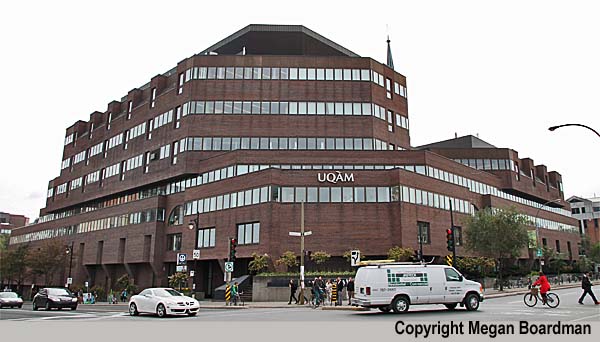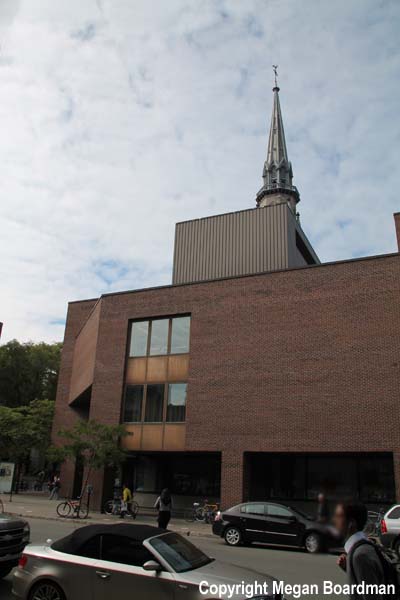Judith-Jasmin
Pavilion, UQAM, Montreal, Canada

Architect
|
Dimitri Dimakopoulos
and Associates and Jodoin Lamarre Pratte et
Associates |
Date Built
|
1976 - 1979
|
Location
|
Rue
Sainte-Catherine |
Description
|
In 1979 L'Université
du Québec à Montréal (UQAM) opened a new
pavilion in downtown Montreal on the site of the
former Church of Saint-Jacques built in
1858. This site, bound by Rue
Sainte-Catherine, Rue Saint-Denis, Rue Berri and
Rue Ontario, has experienced three significant
fires dating back to 1822 when a complex of
religeous buildings were destroyed. Fire
also destroyed the main body of the Church of
Saint-Jacques in 1933. The church was
rebuilt but demolished in 1975 to make way for
UQAM’s new pavilion.
When the architects drew up the design for the
Judith Jasmin Pavilion they incorporated the
bell tower and the transept of the damaged
church into the new building.
As the “patrimoine-religieux.qc.ca” website puts
it, “By way of retaining something of the
flavour and style of the old architecture,
it was decided to place the modern
passageways on the site of the nave and
former transept. Parabolic arches were
designed imitating the structure of the
former church to provide an exterior link
between the buildings. This passageway is
illuminated from light-wells providing the
onlooker with glimpses of the architectural
features which survive from the former
church.”
The university explains that the building is, “
... the nerve center of campus. It also
includes the Galerie de l'UQAM, Salle
Marie-Gerin-Lajoie, the Alfred-Laliberté
studio theater, the general information
kiosk, P'tit Café Jasmin, Coop UQAM, the
Department of Audiovisual Communications and
the Hall of Wood, consisting of works of the
old sacristy. The pavilion also houses the
Faculty of Arts, Faculty of Communication,
the School of Visual and Media Arts, the
School of Theatre, School of Media, research
units and student associations.”
The pavilion is named after Judith Jasmin, a
Quebec journalist born in Terrebonne in
1916. Known first as an actress she went
on, in the 1940s, to become a prominent and
award winning journalist working for
Radio-Canada. In 1966 she was appointed
Radio-Canada’s United Nations correspondent and
later its Washington correspondent.
|
|



